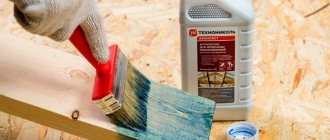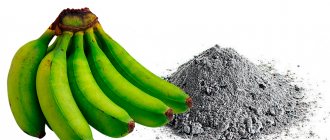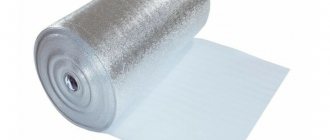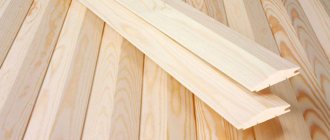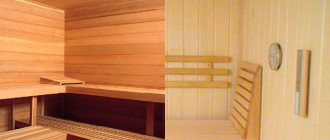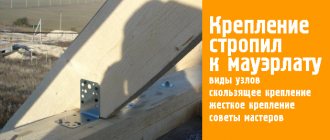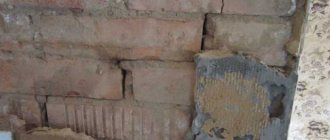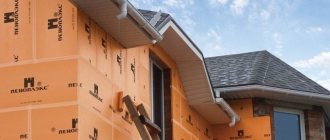7121 0 4
Mullvatt September 6, 2016Specialization: Capital construction work (laying a foundation, erecting walls, constructing a roof, etc.). Internal construction work (laying internal communications, rough and fine finishing). Hobbies: mobile communications, high technology, computer equipment, programming.
Izolon is a thin but reliable insulation.
Izolon is an interesting, from the point of view of operational properties, insulation based on foamed polyethylene, which can significantly increase the thermal resistance of enclosing structures. I often insulated floors, ceilings and walls with isolon, and also used it as an additional heat-reflecting material.
Today I want to talk about the types and technical characteristics of this product. The instructions given below will help craftsmen who perform insulation with their own hands to decide on the choice of thermal insulation material for the job.
Sequence of work during insulation
When working with isolon, you must adhere to the basic rules of installation and operation, which will allow the insulation to last longer, performing its duties efficiently.
Insulation of ceiling and floor with Izolon
This material has a small thickness, therefore, in order to obtain a high-quality thermal insulation cake, it is often combined with other insulation materials, for example, mineral wool.
The ceiling insulation method consists of the following steps:
- Mineral wool is laid between the ceiling joists.
- Isolon is attached stretched along the joists.
- They stuff the counter-lattice.
- Apply the finishing touches.
Isolon can serve as a sound insulator, for which it is placed directly under the finish. In this case, the material is attached end-to-end to the working surface using a construction stapler.
Note! If possible, it is better to leave a gap between the isolon and the finish necessary for the evaporation of moisture. When insulating the floor with isolon from the inside, the work order looks like this:
When insulating the floor with isolon from the inside, the work order looks like this:
- Dismantling the old coating. If insulation is carried out in an old house, then first of all it is necessary to dismantle the existing floor covering.
- Preparing the base. At this stage, the underlying structures are restored: the cracks are sealed, a new screed is poured.
- Installation of floor waterproofing. The base is coated with a primer. After it has dried, the surface is covered with plastic film or a waterproofing membrane. Coating waterproofing can also be used.
- Laying a thermal insulation layer. Sheet or roll insulation is adjusted in size so that it covers the entire surface. The joints are sealed with foil tape - there should be no gaps at the bottom, as they significantly worsen the thermal insulation properties.
- Waterproofing material is laid on top of the isolon and a fine finish is provided.
Note! If necessary, double-layer insulation is installed
Wall insulation with Izolon
As a rule, such work is carried out using additional insulation - mineral wool.
- Wooden blocks for the future counter-lattice are attached to the wall.
- Mineral wool is laid between the bars.
- Foil-coated isolon is nailed on top of the bars. Its shiny side should be directed towards the room.
- The rolls are laid end to end. Existing cracks are covered with aluminum tape.
- The counter-lattice is nailed.
- The trim is attached.
Additional Information! A gap of at least 15 mm should be left between the finishing material and the foil.
Methods for laying isolon
When insulating the walls of a house from the inside with the help of such a reflective heat-insulating material, it can be laid both between two walls and between the outer wall and the internal finishing surface.
In both cases, there will be a reflection of not only the heat coming from inside the room, but also the cold coming from outside. This is achieved by foiling the insulation, which can be one-sided or two-sided.
When choosing an option for installing isolon, it is necessary to take into account the architectural features of the building design.
When working with isonol, it must be remembered that the greatest effect from this heat-insulating material is obtained if there is an air cushion between the insulation and the wall. It should not be more than 15-20 mm.
To create an air cushion, you need to stuff, in a checkerboard pattern, slats 1 to 1.5 meters long.
The distance between them should be no more than 1 meter.
The insulation should be attached to them using small nails or a furniture stapler. The joints between pieces of isolon must be carefully taped with an aluminum stapler.
After the insulation is properly strengthened, slats are nailed onto it, onto which the finishing layer of the inner wall will then be mounted.
Isolon laid in this way will prevent heat loss.
The air gaps created will promote thermal reflection. They will send cold air back outside, and warm air into the house.
To achieve maximum effect, it is better to give preference to isonol foiled on both sides.
Properties of folgoizolone
Foil-coated isolon has the same properties as regular one, but with some advantages:
- retains heat according to the principle of a thermos;
- moisture resistant;
- immune to temperature changes;
- elastic;
- has excellent soundproofing effect.
- very thin and light;
- resistant to external physical influence;
- fireproof;
- environmentally friendly material;
- resistant to chemical attack.
The characteristics of foil-coated isolon are also practically no different from regular ones, since:
- It can be operated at temperatures from – 80 to 120 degrees Celsius.
- The ability to reflect more than 95% of radiation is its main difference from its conventional counterpart.
- The heat retention rate is very high - 1.95. For ordinary brick walls, for example, this figure is 0.88.
- The coefficient of resistance to heat transfer for a sheet of foil-coated isolon 5 mm thick is 1.2. This is also a very good result (the larger it is, the better), since for the same glass wool with a layer thickness of 5 cm this coefficient is 1.39.
- Heat transmittance coefficient (closer to zero is better) – 0.04. Brick walls – 0.52.
- Foil-coated isolon absorbs no more than 1% of liquid that gets on its surface.
- Can be used for up to 40 years.
Advantages and disadvantages
The porous structure with cross-linked molecules provides the following properties of the Izolon material:
- Excellent ability to retain heat and sounds. A polymer with a thickness of 1 cm in terms of thermal insulation properties corresponds to 15 cm of brickwork or 5 cm of solid pine timber; slightly superior to polystyrene foam and mineral wool (they will need 1.5 cm).
Foamiran is a decorative variety of PPE Source shopify.com
- High level of waterproofing. Thanks to the closed pores filled with air, the material practically does not absorb moisture and remains vapor-tight.
- High inertness in contact with oil and petroleum products, with chemical compounds; Izolon is compatible with most building materials.
- Impressive service life: manufacturers talk about 80-90 years without loss of performance properties.
- Health safety. The material does not emit substances that are hazardous to health or cause allergies, does not rot and does not become a haven for microorganisms and fungi.
Builders note the following advantages of Izolon:
- Elastic and lightweight insulation makes installation simple and quick. It is easy to process - just a sharp knife is enough to cut the workpieces to the desired size.
- Reasonable price and no waste make it an economical insulation option.
- The polymer is resistant to atmospheric factors and solar ultraviolet radiation, so it is used for facade (external) insulation.
Isolon blocks serve as a reliable shock absorber Source prom.st
See also: Catalog of companies that specialize in home insulation
The following features of foil insulation can turn into disadvantages:
- Low strength. It is also typical for other insulators of this class: any of them is easy to pierce, so care is required during installation.
- Foil materials require a ventilation gap of 1-2 cm; this helps to avoid the formation of condensation, but at the same time increases the cost of insulation.
- With constant high humidity, the aluminum coating begins to corrode, and over time the thermal insulation ceases to perform its functions.
Types of material
At its core, this material is polyethylene foam. Unlike standard polyethylene foams, isolon is elastic and also has a cellular structure.
The material can have different densities and thicknesses, which indicates the versatility of isolon.
The manufacturing technology is very complex, as it involves careful processing of the original raw materials.
Currently, there are different types of isolon;
- isolon PPE;
- isolon NPE.
The first type is cross-linked polyethylene foam with a transverse structure. But NPE is extruded polyethylene foam, whose structure is not cross-linked. Both species are different from each other at the molecular level, but they are also quite similar in appearance. These are the two main categories of isolon, but there are several other types.
At the top is the structure of uncrosslinked polyethylene foam, at the bottom is crosslinked.
Advantages and disadvantages
Do-it-yourself insulation of a bathhouse with isolon: the method of specialists
This material is made on the basis of foamed polyethylene. It has different thickness and appearance of the coating. It also reflects the heat emanating from the walls.
Izolon is resistant to sudden temperature changes. It retains its appearance and properties at temperatures from -85 to +125 C.
the material has a different texture: uniform or cross-linked. Choose any option for insulating the bathhouse.
The advantages of isolon are:
- heat retention up to 90%;
- minimal reduction in steam room area;
- it is possible to independently insulate the walls of the steam room with this material;
- Isolon is resistant to moisture;
- affordable cost of material;
- no corrosion;
- When the material heats up, it does not produce harmful substances.
But this material also has disadvantages:
- sizing of joints is required;
- there is exposure to mechanical damage.
It is best to choose roll insulation for a bathhouse. It is much more convenient to work with him.
Peculiarities
The demand for such raw materials is explained by the need to insulate all buildings, regardless of the material used to construct the building.
Of course, for any homeowner the issue of simplifying this task and saving money on work will always be relevant. This issue can be easily resolved by choosing practical and high-quality products. Among the variety on the market, a product such as izolon stands out. This is a material whose use will not only insulate the working base, but also create a high level of sound insulation. What is relevant for city houses located near noisy highways.
In addition, the justification for using insulation to preserve heat is confirmed by proven facts indicating that heat loss in rooms that occurs through the walls of a building accounts for 65% of the total value.
The construction products market is regularly replenished with materials that perform a thermal insulation function.
The main feature of the material is its wide range of applications - it is used mainly in construction, but is also purchased for use in the automotive industry and other areas of production.
In the first case, we can distinguish the following types of work for which isolon is purchased:
- insulation and sound insulation of roofs, walls, floors, interfloor ceilings;
- vapor barrier of baths and saunas.
Automotive production requires the availability of material in the following areas:
- body insulation from the inside to minimize vibrations and noise, thermal insulation;
- ensuring metal protection from corrosion.
In addition to the above-mentioned areas of use of the material, it is in demand in the medical industry, in the production of refrigeration equipment, sewing workwear, in the packaging industry, and so on.
Sometimes such products are used in conjunction with its analogues. But in comparison with most materials, isolon stands out from the general list with its positive features.
- Russian products are characterized by a lower cost, in contrast to foreign materials, as well as expensive cork. In addition, the material in question has almost the same properties as cork.
- Compared to glass wool, isolon is much easier to install; in addition, it does not cause allergic reactions.
- Polystyrene foam is inferior in quality because it is chemically active, which means it is not recommended for installation in residential premises.
Scope of application
A universal set of characteristics contributes to the widespread use of Izolon; Application covers the following areas of the economy:
- In construction. With its help, heat and waterproofing of walls, floors, floors and ceilings is arranged. It is needed for waterproofing communication systems, basements and foundations, for insulating balconies and loggias. The fabric copes well with thermal insulation of saunas and baths - objects with regular fluctuations in temperature and humidity.
PPE in floor insulation Source stroyfora.ru
- Automotive industry. Thermal fabric is used for interior trim; it not only reduces heat loss, but also reduces vibrations and protects against noise. It is also used to make various sealants to protect against corrosion.
- Mechanical engineering. Izolon is used to insulate the surfaces of refrigeration equipment, air conditioners, and heat-reflecting screens. It is used to produce seals and vibration isolators.
- Manufacturing of medical products. These include a variety of thermal blankets and orthopedic products (for example, insoles).
- Production of consumer goods (household goods), including for recreation, sports and tourism. Polymer is used to make fillings for life jackets, mats, helmets, shields, gloves and punching bags.
- In the furniture, leather goods and footwear industries.
- As packaging material. Its shock-absorbing properties are important here, protecting the finished product from deformation.
High-quality sound insulation of the car interior Source recn.ru
DIY crafts from isolon
Master class on making a lamp in the shape of an owl from isolon
To work, we will need a thin sheet of isolon, which must first be prepared, namely, cut into squares, 3 × 3 cm², forming “feathers”.
The procedure can be seen more clearly in the photo instructions. To work, we will need a small lampshade, which must first be disassembled into 2 parts, isolon, scissors, and glue. In addition, we will need wire with which we will make the frame of the wings
Please note that the wire will have to support a fairly large number of feathers. Be sure to use an LED lamp as a backlight, it is more durable, and you will not need to open the structure often
| Illustration | Description of action |
| Cut the isolon into squares. It's okay if the squares aren't perfectly straight. To speed up work, it is best to roll the isolon sheets in several layers | |
| Next, we give these squares a petal shape approximately like this. We cut each leaf so that we get a fringe. | |
| To make the head we will need foil and corrugated paper. We roll the corrugated paper noodles, cut into thin strips about 1.5 cm wide, into a ball and wrap them with foil. We got this blank for the head | |
| We wrap it with a sheet of heated isolon so that we get such a round blank, tighten the base with tape or an elastic band for banknotes. Cut off the excess. The diameter of our head for the owl turned out to be approximately 10-12 cm | |
| We attach the head with hot glue, in fact, it turns out to be such a snowman. Carefully glue the workpiece in a circle | |
| We begin to cover our blank with feathers from the bottom up so that we have a fluffy body. The higher you go to the head, the smaller the feathers should be. We glue the next row in relation to the previous one in a checkerboard pattern. | |
| Having reached the head, we begin by gluing the area under the eyes. This needs to be done at the very beginning, otherwise you simply won’t be able to make them on top of the glued row later. | |
| For the eyes, we chose a ready-made option, which can be bought on AliExpress or in any craft store | |
| Next, we continue to work according to the usual pattern - checkerboard, trying to avoid gaps | |
| Now it's time to start decorating the wings. We attach the blanks to the base. The process of creating voluminous feathers is similar to the design of the body. | |
| Our owl is almost ready. Now it's time to make the ears. To do this, we wind the isolon tape into a small skein, glue the base and make a fringe | |
| We attach our ears to glue, slightly fluffing the tops. Now all that remains is to complete the final finishing by covering the rest of the head with makeshift feathers. To give our lamp the appearance of natural plumage, you can slightly fluff the feathers by directing the warm jet of a hairdryer | |
| This is how our volumetric lamp made of isolon in the shape of an owl turned out |
You can watch all the stages of work in more detail in this video:
Watch this video on YouTube
Lamps in the form of flowers from isolon
Izolon is most often used to make beautiful jewelry and decorative flowers. These masterpieces are almost indistinguishable from the real thing. Despite the apparent complexity of the work, giant plants made from isolon are the simplest craft that a novice craftsman can complete.
For work we use familiar objects:
- 5 strips of isolon 1 m long, 15, 15, 23, 30, 33 cm wide;
- plastic container with lid;
- cartridge;
- glue gun
Watch the video in which the author explains in detail how to make a flower from isolon with your own hands. He got a huge rose. You can decorate your garden plot with it. If you are starting a renovation, save some isolon to make this luxurious flower.
Watch this video on YouTube
Master class on making a lamp in the shape of a doll from isolon
Almost any lamp can be made in this way. For example, the author of the following video explains in detail how you can make an unusual lamp for a child in the shape of a doll. This idea will make your child absolutely delighted.
Watch this video on YouTube
Composition of isolon and its characteristics
Izolon is made by foaming polyethylene, so its structure consists of many closed air pores in the synthetic material. The material is elastic, but very soft, so it can be laid on almost any geometrically complex surface. A special feature of the production of isolon is a thin foil layer of aluminum, thanks to which heat is reflected back into the room, and because of this, the main layer of insulation can be made much thinner than the usual 50-100 mm. Izolon has an initial thickness of 2 mm, and this parameter can increase to 100 mm, depending on the application. Thus, insulating a balcony with isolon will require a layer 20-30 mm thick, since the room is always located on the street. Foamed polyethylene is sold in rolls, sheets, strips or blocks.
According to the manufacturing method, isolon is of the following types:
- Foil-coated isolon NPE (the abbreviation stands for non-crosslinked polyethylene foam). It can be of different densities and thicknesses, with a regular and self-adhesive surface. Technology – method of extrusion and foaming with butane gas;
- Foil-coated isolon PPE (the abbreviation stands for cross-linked polyethylene foam). The technology for producing NPE material differs only in the use of another reagent - porofor, which makes it more environmentally friendly due to the absence of freon.
Structure and scheme of application of isolon Technical and operational parameters:
| Characteristic | Foaming ratio | ||||
| 30 | 20 | 15 | 10 | 5 | |
| Density, kg/m3 | 33 | 50 | 66 | 100 | 5 |
| Nominal thermal conductivity, W/m•K | 0,031 | 0,033 | 0,036 | 0,039 | 0,041 |
| Water absorption, cm3/m2 | 0,7 | 0,5 | 0,4 | 0,3 | 0,2 |
| Operating nominal temperature | -60°С + 100°С | ||||
| Sound absorption | at 250 Hz -7%, at 2000 Hz – 38%, at 6000 Hz – 60% | ||||
| Thermal energy reflection coefficient | from 95% to 97% | ||||
| Moisture permeability | < 1% | ||||
| Product thickness | from 2 mm to 100 mm |
Comparison of the characteristics of different insulation and building materials Isolon vapor barrier is divided into the following brands:
- Foil insulation PPE 500, 500-L - based on polyethylene cross-linked in a vertical oven with a bonded transversely directed structure;
- PPE 500 NR – based on polyethylene cross-linked in a horizontal oven with a bonded transverse structure;
- PPE 500-300 – polyethylene chemically cross-linked in a horizontal oven;
- 100, 100-L – non-cross-linked polyethylene with a molecular structure based on EPPE (extruded polyethylene foam).
Practical application of extruded polyethylene foam for home insulation Types of reinforced thermal insulation materials based on polyethylene foam:
- PPE with increased wettability characteristics, intended for painting and gluing;
- Izolon with increased rigidity properties;
- Insulation in a wide range of colors;
- Izolon with additives of fire retardants, as a result of which the degree of flammability of PPE is reduced.
https://youtube.com/watch?v=JLr-UiwEvNc
Specifics of Izolon
Izolon is produced by foaming polyethylene with small cells and closed pores
Izolon based on fine-cell polyethylene foam has high thermal insulation properties and low weight. Some modifications are made with single- or double-sided lamination with aluminum foil. The thickness of the coating is 14 microns and provides waterproofness as well as reflective properties.
The material also has a reinforced frame in the form of a propylene mesh. The basis of Isolon is self-adhesive or glueless. There are combined varieties with foil and adhesive base on sale. To prevent the sheets from sticking together during transportation, a protective film is applied to the adhesive surface.
Floor insulation with isolon: installation features
To thermally insulate a floor using isolon, you will need to have not only the insulation itself, but also foil tape for sealing the joints. In addition, you will need a construction knife to cut the material. Installation should begin with preliminary preparation of the surface that you will insulate. If necessary, you need to level the floor using a concrete screed. In addition, it is mandatory to clean the surface from dirt and dust.
After completing the preparatory work, they begin laying the heat insulator itself.
They do it like this:
- Cut the sheets to the required size;
- Lubricate the surface with adhesive;
- Fix the material tightly on the insulated surface using tape;
- After fixing, the joints of the material are glued with foil tape with an adhesive base.
Your floor is ready for installation of any floor covering or underfloor heating system equipment.
Advantages and disadvantages
Isolon insulation has many advantages, which makes it so popular:
- safe, does not have harmful effects on human health;
- due to low water absorption and vapor permeability, the insulation can be used without a waterproofing layer;
- elastic, therefore easy to install in difficult places. At the same time, it is elastic, so it easily returns to its original shape after dismantling and can be reused;
- precipitation and ultraviolet radiation are not harmful to isolon, therefore it is suitable for outdoor work;
- Izolon is one of the best insulation materials for walls. Example: 10 mm of insulation = 15 cm of brickwork, 20 mm of mineral wool or 5 cm of wood. Heating costs are reduced by almost three times;
- does not put a load on the structures being processed, as it weighs little;
- fireproof;
- service life reaches 80 years;
- During manufacturing, the material is not only covered with foil or metallized film, but also embossed and painted;
- Isolon is easy to use. It is easy to cut and attach to a surface, allowing for a self-adhesive base. A stapler, small nails, self-tapping screws or silicone glue can also be used for fixation;
- waste raw materials are reused;
- aggressive chemicals and biological destroyers do not affect the material;
- wide choice in terms of sizes, density, thickness.
There are isolona and disadvantages, but there are far fewer of them:
- relatively high price;
- the thin aluminum layer is easy to damage, so you should work with the material carefully. The same applies to its transportation;
- Isolon is not plastered, not covered with wallpaper and other finishing materials that can “load” it, which can lead to breakage of the insulation.
Note! For any work with the material, for example, if you need to insulate the floor in a wooden house using isolon, you will need at least basic skills in construction, otherwise there is a chance of damaging it. Damaged insulation will no longer be 100% effective.
How is thermal insulation performed with isolon?
Insulation of the floor in a house made of timber can be done in three ways. Below we will look at each option separately.
First way
Extruded polystyrene foam slabs are laid on the leveled ground, and the seams between the sheets are foamed with polyurethane foam.
A concrete screed is placed on top of the insulation. It is necessary that the concrete base is level, without cracks or other defects. If there are cracks, they must be filled with putty and then sanded.
After cleaning the surface from dust, rolls of isolon are placed on it (the protective film must first be removed from the material), which are fixed to the floor with glue or dowels. The sheets are glued together with foil tape.
Second way
The pre-leveled soil is covered with a waterproof membrane, then mineral wool slabs are placed on it. A waterproofing film is also laid on top. The lower hydromembrane protects the insulation from moisture coming from the ground, and the upper one does not allow it to enter the room.
Floor joists are installed on which boards are laid. The floor is insulated on top of them. Isolon is spread over the insulated surface and secured with a stapler or screwdriver. The joints are sealed with tape with a foil layer. Then the floor covering is laid.
Floor insulation along joists:
- Remove old flooring.
- Lay wooden logs on the rough base at a distance of 600-1000 mm from each other. Before laying, beams must undergo antiseptic treatment to prevent rotting.
- Between the lags, boards or plywood sheets are laid on special cranial bars.
- A layer of waterproofing is laid on the prepared wooden base, and then sheets of insulation are laid out so that the upper edge of the material is lower in height than the joist. Izolon itself has vapor barrier properties, so there is no need to lay a vapor barrier film on top.
- A finishing flooring is laid on top of the heat insulator. To arrange it, boards more than 3 cm thick or sheets of plywood are usually used, which are laid in a perpendicular direction to the beams.
- The finishing floor covering is laid on top of the insulated base.
Recommendations for use
When choosing foil insulation, you should decide on its thickness, which depends on the place to be insulated. To insulate the floor, a thickness of 0.2-0.4 cm is sufficient. For insulation of interfloor ceilings, rolls or layers from 1 to 3 cm are used. If isolon is used as a sound insulator, a thickness of 0.4-1 cm is sufficient.
Styling Tips:
- foil-coated isolon should not come into contact with electrical wiring. Foil is a metal that is an electrical conductor;
- When insulating a balcony, you should remember that isolon only retains heat, but does not generate it. Accordingly, insulation is half the task; you will also have to take care of the availability of heat sources;
- the air gap will prevent condensation accumulation;
- the material is laid end-to-end, and the joints themselves are covered with aluminum tape.
If you do all the work correctly, taking into account all the requirements, then when insulating the balcony you will have to sacrifice a small internal area. It will be occupied by mineral wool.
Foil-coated isolon is a material used for moisture, noise and heat insulation in both residential and industrial premises. Despite its small thickness, it effectively performs its duties. But in order for the insulation to last longer, it is necessary to adhere to the installation rules.
How to choose?
When choosing material for making life-size flowers, experts recommend paying attention to several criteria for a good purchase. For example, not every average person knows that today there are many analogues and even surrogates for isolon
For example, the scope of application also matters. Izolon, which successfully replaces foamiran, can be used to create large flower arrangements, individual elements of wedding dresses, decorating festive tables, buffets, children's parties, store stands and even landscape design. You need to choose a material option based on this. At the same time, not only colored but also white isolon is suitable for decoration.
Brand
The first thing you need to know: the name “izolon” is a manufacturer’s brand. The products of other companies are noticeably inferior in quality, properties and characteristics. A high-quality and genuine handicraft product produced by the brand is nothing more than foamed polyethylene, which is shaped into a roll with an average thickness of 2 to 10 mm.
Material type
Regardless of the production method and type of raw materials, craftsmen use mainly cross-linked polyethylene for their work. It differs from other analogues in its smoother texture, greater elasticity and durability.
Price
Don't chase cheap materials. Physically cross-linked PPE is more expensive than its analogues. In practice, although other materials are cheaper, their surface is characterized by roughness, which does not allow the use of similar isolon for work. In other words, a cheap product purchased may remain idle.
Place of purchase
Today, you can purchase products from the Izhevsk Plastics Plant from the manufacturer itself and its official suppliers. If you are offered, for example, analogues such as “Aksalut” or “Penolon”, then they are noticeably inferior in quality to isolon itself. You need to take products from trusted suppliers, asking them to make light copies of the certificate, which is the accompanying documentation for each type of isolon.
Width and thickness
Considering the different possibilities of the material depending on the size and colors, when choosing, it is worth noting: the best material for creativity is considered to be meter-wide isolon. From such products you can make life-size flowers up to 1 meter in diameter. A one and a half meter wide roll analog allows you to create flowers with a diameter of up to 2 m. However, the shape of such a flower will hold better if it is made from denser raw materials.
Color
The color decision when purchasing is based on the preferences of the buyer. Traditional colors are white and green. Often, for greater resemblance to real flowers, craftsmen prefer to take material in related shades of the same color. Otherwise, the choice of color will depend on what kind of flowers you plan to make. The outer surface of the material can be different (for example, it can be embossed with a pattern).
Density
As for density, its indicators, depending on the type of material produced by the brand, can be 26, 33, 50, 100 and 200 kg/m3. Standard values for typical raw materials for creativity are 33 kg/m3.
Delivery
When buying rolled isolon, you need to take into account: the manufacturer cooperates with different companies and can deliver raw materials for creativity to different parts of our country. Delivery conditions must be negotiated privately, which will allow the buyer to eliminate the possibility of any problems in the future and choose the desired version of the product for creativity. It is also worth considering that material with a smaller width can more easily withstand delivery across the country.
Amateurish technology
The origins of balcony disasters originate in the following statements:
- “for normal high-quality insulation of a loggia, in order for it to be as warm as in an apartment, ordinary insulation with a thickness of 10 millimeters is enough
“; - using expanded polystyrene is “ the height of stupidity and inefficiency
,” since isolon “
has higher thermophysical characteristics
.”
Based on these stupid tips, people are sold a miracle technology for insulating balconies and loggias, which is built according to the following scheme:
The author of the above statements and thermal insulation technology is a person who can speak confidently on camera, but does not understand construction and repairs.
We called his technology
Amateurish
. After all, any competent builder knows that 1 cm of isolon is extremely insufficient for insulating balconies and loggias. Further in the text we will confirm our words.
REMINDER. Expanded polystyrene (foam) or mineral wool are often used for thermal insulation of building structures. Both of these materials retain heat approximately equally, but the main thing is that they are laid in layers not 1 cm thick, but on average 10 cm thick. Perhaps this is because they are really much worse than the super insulation isolon and are not capable of protecting the balcony from frost with the thickness of a finger? But is this really so?
Argument No. 2. Super insulation is a myth
The first indicator of thermal efficiency - the ability of a material to retain heat - is the thermal conductivity coefficient, which is denoted by the letter "?" – lambda.
? (W/m°C) is the amount of heat in watts (W) passing through a layer of material 1 m (meter) thick if the temperature difference between its opposing surfaces is 1 °C (degree Celsius).
- How ? The smaller the better the insulator.
- ? depends on the nature of the material and does not depend on its thickness. Coefficient of thermal conductivity ? is a laboratory value that is measured on samples of the same size.
Place two frying pans on the fire - one with cast iron and one with plastic handles. Soon the handle of the first frying pan will become scalding hot, and the handle of the second will remain cold. This is a result of the fact that metal has a much higher thermal conductivity coefficient than plastic.
Let's compare the lambdas of several popular insulation materials. Data about them can be found on the websites of thermal insulation manufacturers, as well as in regulatory documents (we took higher values from SP 50.13330.2012):
- Izolon (foamed polyethylene) – 0.036-0.05;
- EPPS – extruded polystyrene foam (TechnoNIKOL) – 0.030-0.034;
- EPS – expanded polystyrene, polystyrene foam (GOST 15588.2014) – 0.035-0.059;
- Stone wool (Rockwool) – 0.035-0.048.
CONCLUSION: Coefficients? all materials are from approximately the same range. Statement that isolon “ has higher thermophysical characteristics
” – illiterate.
Characteristics
We decided to present the main technical characteristics of each option in the form of a table to clearly demonstrate the differences.
| Index | Izolon PPE | Izolon NPE |
| Apparent density | 33 kg/m 3 | 24-45 kg/m 3 |
| Use temperature | -60 C to +75 C | -80 C to +80 C |
| Thermal conductivity | 66 W/m*K | 0.040 W/m*K |
| Water absorption | 0.01 | 0.01 |
| Vapor permeability | 0.001 mg/(m*h*Pa) | 0.001 mg/(m*h*Pa) |
| Sound absorption | Up to 60% at 6000 Hz | 3 – 13% |
If you are interested in whether this material burns or not, then it is advisable to check with specialists when purchasing this or that type. The degree of combustion will be different, for example, for isoplene and teploizolon. The same applies to other types of material.
PPE
NPE
Both varieties can be used without problems for almost a century. The reason for this is the reliability of the materials. The use of isolon is typical for many areas, since it has many advantages.
Video about how this insulation is produced:
https://youtube.com/watch?v=dmxolnXC4_U
Basic techniques for creating flowers from isolon
In order to make a flower from isolon, you need to clearly imagine the original and know thoroughly what each vein in the petal and sepal looks like
In addition, it is important to choose the right shade combination and sizes. After this you can start making templates
Photo zone with flowers from isolon PHOTO: pinterest.nz
What you need for work
A big plus for those who are just starting to master working with isolon: the material does not require the purchase of complex, expensive tools. It is very similar to foamiran, and every home has all the equipment to work with it:
- tailor's scissors, they can be replaced with a mounting knife;
- hair dryer, suitable not only for construction, but also for household use, but with two heating modes;
- glue gun, which must have a temperature switching mode;
- stapler, staples and threads;
- paints: in a spray can or acrylic.
Using a hairdryer, you can give the blanks any shape PHOTO: ytube.tv
How to make a flower
Isolon is often used to make flowers of various sizes: from a tiny bud to a full-blown inflorescence or a composition the size of a person. They can be located on stems, formed into bouquets, and flowers are often used to create three-dimensional panels.
When creating flowers from isolon, it is necessary to take into account some nuances:
- Each flower or bud is assembled from several elements. Small parts are made in sizes 10x10, 12x12 cm², larger ones - from 20x20 to 50x50 cm². When assembled, the diameter of the flower can exceed 1 m;
- The thickness of the isolon is selected depending on the parameters of the flower. For small products you can use material with a thickness of 2 mm, for larger ones - over 3 mm.
Assembling a flower PHOTO: pinterest.ru
Stem
For large growth flowers, the stem must first of all be strong and solid. A pipe made of metal, plastic or metal-plastic is best suited. Plastic elements can be given any bend by heating.
For buds or small flowers you can use the following material:
- wire, it is better to choose it with ready-made green insulation;
- thin metal rod;
- plastic cocktail straw.
For a small stem, ordinary wire is suitable PHOTO: livemaster.ru
Petals
The technique for forming the petals of different flowers is different; when making your own, use the following recommendations.
| Illustration | Flower | Flower formation technique |
| PHOTO: youtube.com | Rose | First, a bud is formed, half-opened and opened petals are placed around it |
| PHOTO: youtube.com | Peony | For a peony, a half-open bud is used; the petals have a carved edge at the top. |
| PHOTO: skillofking.com | Tulip | The flower consists of four petals, connected in pairs around a stem |
| PHOTO: pinterest.ca | Chrysanthemum | For a chrysanthemum you need to prepare a large number of thin petals that are connected around the stem |
Stand
Most often, the following options are used as a stand:
- welded structure made of steel base;
- a concrete stand, this option is similar to a welded structure, with the exception of the base, which is filled with mortar;
- a stand from different containers, into which cement mortar is poured, and before it hardens, part of the rods from the flowers is inserted.
Metal stands PHOTO: salvabrani.com
Nuances of fastening and installation
Installation of insulation is not difficult; it is easy to cut and install. The work on the outside and inside is almost the same.
Main nuances:
- the surface on which the insulation is placed must be clean;
- the material is straightened so that it is smooth, without wrinkles;
- foil prevents heat from escaping, so it is laid with the outer side up;
- the insulator is glued end-to-end, the joints are taped;
- If the insulation does not have a self-adhesive layer, use special glue.
It is important that the glue used for fastening does not emit harmful substances and holds the material firmly
Walls
The slabs are mounted using dowels on vertical surfaces
Installation of insulation to the wall must be thoroughly thought out. An air gap is left between the material and the subsequent finishing to avoid condensation.
- The membrane is fixed and the insulator is rolled out on top of it.
- The material is fixed with slats. Their thickness should be greater than the main insulation.
- Along the edges of the slats, the insulator is connected with staples.
- The panels are finished over the slats; their thickness provides the necessary air gap.
Preparation before installation
Nowadays it is popular to lay insulation with a thickness of no more than 10 mm on the floor. Izolon can be placed in any room to avoid heat loss. But first you need to remove the old flooring and remove all debris.
Laying isolon insulation can be done independently without much difficulty
After this, you should inspect the underlying structure, where there should be no damaged screed. It is best to pour new cement mortar. In addition, it is necessary to check the reliability of the butt seams. Any holes on them must be sealed with foam. Before laying isolon, do not forget about waterproofing the base. To do this, the floor is covered with a primer, and when it dries, polyethylene must be laid on top of it. It is recommended to secure the film with tape.
